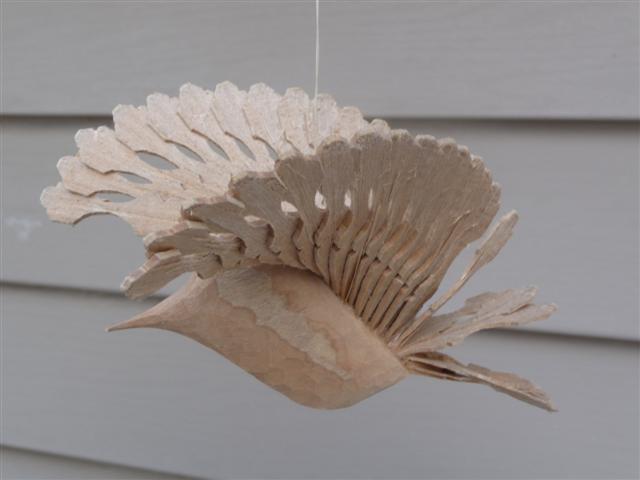Fan-Carved Peace Birds
View the new and exciting carvings by my wife, Carolyn
Fan-Carving
Fan-carving is the process of slicing wood into thin blades or feathers and then turning and interlocking them to create a 3-dimensional design from one piece of wood.
May a little Peace Bird be a secret-silent reminder to invite the Spirit of Peace to dwell...
 |
In this picture you see Carolyn's hands carefully fanning the blades or feathers of a bird in order to complete the process of making a fan-carved bird. These individual feathers are not detached and then glued on. They are turned while the wood is wet which allows the wood fibers to turn without breaking. Once this has been successfully completed, the bird can be allowed to dry out and have a string attached, from which they will gently turn in a breeze, simulating the action of a real bird. |
| Pictured to the right is a completed bird that has been allowed to dry and is gently blowing in the breeze as it hangs from a thread. These birds can be seen hanging in a variety of places, like lamp shades, in windows, from rear view mirrors and as Christmas tree ornaments. |  |
The shape of the bird is determined, in part, by how the bird is fanned. In the one pictured above, Carolyn started at the top and fanned the feathers down. In the two views of the bird below, you can see what happens when you start at the bottom and fan your way to the top,
 |
|
Fan carving is an ancient art form, coming out of Russia and has been found in Scandanavian countries and other areas of eastern Europe. It has been associated with religious and spiritual symbols, and has been used as a symbol of peace. There are pictures of some larger versions of fan-carved birds hanging in Russian Orthodox churches, above the area where the sermon would be delivered.
How are they made?
|
Each bird starts as a little block of wood, like those pictured to the right. After they are cut to this size, they are then boiled for several hours (notice how wet the wood looks), and then literally, live in water throughout the entire process. It is only after they have been successfully fanned that they can be allowed to dry. Once they are dry, they are very delicate, but not fragile. |
.jpg) |
What are the steps involved in making fan-carved birds?
The steps include cutting the bird to the basic shape, making the hinge cut where the blades will be rived--or sliced to make the thin feathers. then riving/slicing the individual blades or feathers. Once the riving has been accomplished, the carver will often go back in and make the hinge cut even thinner, so there are less fibers to be twisted when the interlocking step is done to fan out the feathers.
The three basic cuts are the interlock cut, the hinge cut and riving or slicing the individual blades or feathers.
.jpg) |
In the picture to the left, Carolyn is performing one of the most critical steps in fan-carving, the rive, or slicing cut that makes the thin blades or feathers. |
In the pictures below, Carolyn is begining the final step in creating fan-carved birds. In the picture to the left, she is starting to separate the blades or feathers, so that she can begin the twisting and the interlocking of the feathers. Notice the separate blades/feathers have been rived or carved. She has the bird in a special tool that holds the body, so she has two hands free to begin the twisting motion. In the center picture, she has several of the feathers already twisted and in place. In the picture to the right, the bird is beginning to take shape, as she works on what will be the tail feathers.
 |
 |
.jpg) |
Pictured below are eight of the birds Carolyn has carved and are representative of her craft. They include those fanned from the top (first row, far left); and one example fanning from the bottom (second row, far left). The seated bird is in a nest made from discarded and damaged blades or feathers. The smallest bird pictured is in the top row, far right. It measures about 2 and 1/2 half inches from the tip of its beak to its tail, and has a two-inch wing span.. The other birds are somewhat larger, with the largest being six inches from the tip of its beak to the tip of its tail, with a four-inch wing span. The bird that was fanned from the bottom to the top (second row, far left) is a little wider, having a five and 1/2 half inch wing span.
 |
.jpg) |
 |
 |
 |
 |
 |
 |
How can I obtain one of these Fan-Carved Birds (you ask)?
Carolyn will be exhibiting these birds at most of the shows listed in the show schedule on the front page. If you are interested in learning more about fan-carving, or obtaining one of these birds, contact Carolyn at carolyn@arquistudiogo.com.
For additional information regarding Fan-Carving please visit the web site of David and Sally Nye of Michigan. They are the people who are introducing this ancient art form into the United States and have published two books on the subject. Carolyn spent some time studying with them, and credits them with getting her interested and started in this craft. Their web site is www.fancarversworld.com

.jpg)